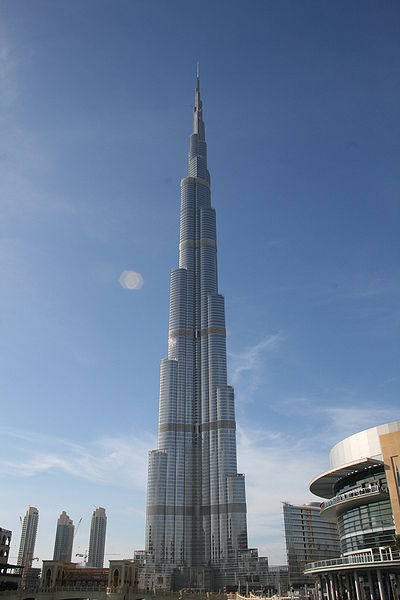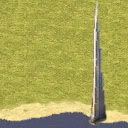wolf_brother
King
Next up in my series of modern wonders, the Burj Khalifa (more popularly known as the 'Burj Dubai'), the tallest building in the world, and the largest structure ever built by man in the modern age.


Includes Building Large & Small PCXs, as well as City Screen buildings Large & Small PCXs. No Wonder Splash at this time.
Download


Includes Building Large & Small PCXs, as well as City Screen buildings Large & Small PCXs. No Wonder Splash at this time.
Spoiler :
#BLDG_Burj
^
^The [Burj Khalifa] makes one unhappy citizen $LINK<content=GCON_Moods> in its city. It also causes its city to produce one extra $LINK<Commerce=GCON_Commerce> in every square that already produces at least one.
#DESC_BLDG_Burj
^
^[Burj Khalifa], known as Burj Dubai prior to its inauguration, is a skyscraper in Dubai, United Arab Emirates, and the tallest man-made structure ever built, at 828 m. Construction began on 21 September 2004; the building officially opened on 4 January 2010. The building is part of the 490-acre flagship development called Downtown Burj Khalifa at the "First Interchange" along Sheikh Zayed Road, near Dubai's main business district. More than 1,000 pieces of art adorn the interiors of Burj Khalifa, while the residential lobby of Burj Khalifa will have the artwork of 196 bronze and brass alloy cymbals representing the 196 countries of the world. The visitors in this lobby will be able to hear a distinct timbre as the cymbals, plated with 18-carat gold, are struck by dripping water, intended to mimic the sound of water falling on leaves.
^
^The total cost for the Burj Khalifa project was about US$1.5 billion; and for the entire new "Downtown Dubai", US$20 billion. The project's completion coincided with a worldwide economic slump, with Dubai itself mired in a deep financial crisis that forced it to seek repeated billion-dollar bailouts from its oil-rich neighbor Abu Dhabi, the opening ceremony and surprise renaming of the tower to Burj Khalifa, after UAE President Khalifa bin Zayed Al Nahyan, has been viewed by observers as an "attempt to boost confidence in Dubai by showing who is backing Dubai".
^
^The design of Burj Khalifa is derived from patterning systems embodied in Islamic architecture. According to the structural engineer Bill Baker, the building's design incorporates cultural and historical elements particular to the region. The Y-shaped plan is ideal for residential and hotel usage, with the wings allowing maximum outward views and inward natural light. The design architect Adrian Smith has said the triple-lobed footprint of the building was inspired by the flower Hymenocallis. The tower is composed of three elements arranged around a central core. As the tower rises from the flat desert base, setbacks occur at each element in an upward spiralling pattern, decreasing the cross section of the tower as it reaches toward the sky. There are 27 terraces in Burj Khalifa. At the top, the central core emerges and is sculpted to form a finishing spire. A Y-shaped floor plan maximizes views of the Persian Gulf. Viewed from above or from the base, the form also evokes the onion domes of Islamic architecture. During the design process, engineers rotated the building 120 degrees from its original layout to reduce stress from prevailing winds. At its tallest point, the tower sways a total of 1.5 m. The primary structural system of Burj Khalifa is reinforced concrete. Over 45,000 m3 of concrete, weighing more than 110,000 tonnes were used to construct the concrete and steel foundation. Burj Khalifa's construction used 330,000 m3 of concrete and 55,000 tonnes of steel rebar, and construction took 22 million man-hours. A high density, low permeability concrete was used in the foundations of Burj Khalifa. A cathodic protection system under the mat is used to minimize any detrimental effects from corrosive chemicals in local ground water. The consistency of the concrete used in the project was essential. It was difficult to create a concrete that could withstand both the thousands of tonnes bearing down on it and Persian Gulf temperatures that can reach 50 °C (122 °F). To combat this problem, the concrete was not poured during the day. Instead, during the summer months ice was added to the mixture and it was poured at night when the air is cooler and the humidity is higher. A cooler concrete mixture cures evenly throughout and is therefore less likely to set too quickly and crack.
^
^The [Burj Khalifa] makes one unhappy citizen $LINK<content=GCON_Moods> in its city. It also causes its city to produce one extra $LINK<Commerce=GCON_Commerce> in every square that already produces at least one.
#DESC_BLDG_Burj
^
^[Burj Khalifa], known as Burj Dubai prior to its inauguration, is a skyscraper in Dubai, United Arab Emirates, and the tallest man-made structure ever built, at 828 m. Construction began on 21 September 2004; the building officially opened on 4 January 2010. The building is part of the 490-acre flagship development called Downtown Burj Khalifa at the "First Interchange" along Sheikh Zayed Road, near Dubai's main business district. More than 1,000 pieces of art adorn the interiors of Burj Khalifa, while the residential lobby of Burj Khalifa will have the artwork of 196 bronze and brass alloy cymbals representing the 196 countries of the world. The visitors in this lobby will be able to hear a distinct timbre as the cymbals, plated with 18-carat gold, are struck by dripping water, intended to mimic the sound of water falling on leaves.
^
^The total cost for the Burj Khalifa project was about US$1.5 billion; and for the entire new "Downtown Dubai", US$20 billion. The project's completion coincided with a worldwide economic slump, with Dubai itself mired in a deep financial crisis that forced it to seek repeated billion-dollar bailouts from its oil-rich neighbor Abu Dhabi, the opening ceremony and surprise renaming of the tower to Burj Khalifa, after UAE President Khalifa bin Zayed Al Nahyan, has been viewed by observers as an "attempt to boost confidence in Dubai by showing who is backing Dubai".
^
^The design of Burj Khalifa is derived from patterning systems embodied in Islamic architecture. According to the structural engineer Bill Baker, the building's design incorporates cultural and historical elements particular to the region. The Y-shaped plan is ideal for residential and hotel usage, with the wings allowing maximum outward views and inward natural light. The design architect Adrian Smith has said the triple-lobed footprint of the building was inspired by the flower Hymenocallis. The tower is composed of three elements arranged around a central core. As the tower rises from the flat desert base, setbacks occur at each element in an upward spiralling pattern, decreasing the cross section of the tower as it reaches toward the sky. There are 27 terraces in Burj Khalifa. At the top, the central core emerges and is sculpted to form a finishing spire. A Y-shaped floor plan maximizes views of the Persian Gulf. Viewed from above or from the base, the form also evokes the onion domes of Islamic architecture. During the design process, engineers rotated the building 120 degrees from its original layout to reduce stress from prevailing winds. At its tallest point, the tower sways a total of 1.5 m. The primary structural system of Burj Khalifa is reinforced concrete. Over 45,000 m3 of concrete, weighing more than 110,000 tonnes were used to construct the concrete and steel foundation. Burj Khalifa's construction used 330,000 m3 of concrete and 55,000 tonnes of steel rebar, and construction took 22 million man-hours. A high density, low permeability concrete was used in the foundations of Burj Khalifa. A cathodic protection system under the mat is used to minimize any detrimental effects from corrosive chemicals in local ground water. The consistency of the concrete used in the project was essential. It was difficult to create a concrete that could withstand both the thousands of tonnes bearing down on it and Persian Gulf temperatures that can reach 50 °C (122 °F). To combat this problem, the concrete was not poured during the day. Instead, during the summer months ice was added to the mixture and it was poured at night when the air is cooler and the humidity is higher. A cooler concrete mixture cures evenly throughout and is therefore less likely to set too quickly and crack.
Download



 I've been waiting for just such a spire-science-fictionesque addition for some time.
I've been waiting for just such a spire-science-fictionesque addition for some time. z
z